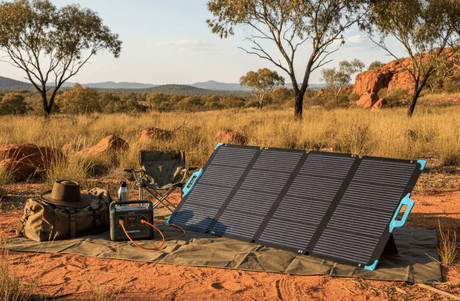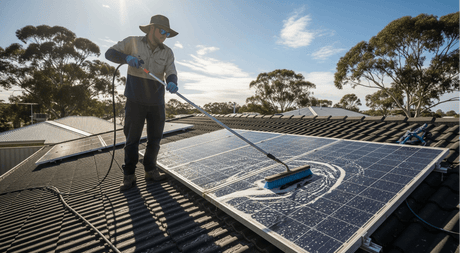With renewable energy becoming more readily available in homes, many people wonder about the ROI on solar panels. In other words, is investing in solar panel installation in Australia worth it?
The return on investment (ROI) on solar panels depends on many factors, including the average cost of solar in your area, tax incentives, and your energy bills. Let’s dive into the details of each of these, along with other aspects of solar energy systems and how to increase your solar panel's ROI.
What Is the Average Cost of Solar in Australia?
A good starting exercise in learning more about solar panels ROI in your region is to discover the average cost of solar in Australia. To do this, you’ll need to look at two measurements, how much it costs per watt to install solar panels and what size solar panel system your home would need. It’s also helpful to calculate your area’s peak sun hours, but more on that later.
Cost Per Watt Installed
When considering prices in the various capital cities of Australia’s states and territories, there is a noticeable range for the cost of installing solar panels. For example, in Perth, a 5kW solar system can go for as little as $3,320, while in Darwin, you might end up paying $9,610.
Because not all dwellings will use a 5kW system, the best way to measure the total cost of equipment and installation is to calculate the cost per watt installed. So, in the case of Perth, we can divide the average 5kW system’s cost of $3,320 by 5,000 (determined by converting kilowatts to watts) to get $0.664 per watt. For Darwin, the same calculation gets us $1.922 per watt.
Part of the reason for such differences between regions or cities is that solar installers ultimately determine how much they charge for their services, which affects the ROI on solar panels. In an area with more solar companies or where solar is in higher demand, prices tend to drop.
Size of Solar Panel System
Another significant factor influencing the total cost of installing a solar system is the system’s size. Solar companies usually charge more to install smaller systems, whereas systems over 7.5kW tend to get you a discount on parts or labour.
But how do you know what size system your home requires? Again, you’ll want to do some math to figure it out accurately. The first number to calculate is how much electricity your home uses in a year. There are a couple of ways to do this, depending on how precise you want to be.
The easy option is to take your most recent utility bill and determine how many kilowatt-hours (kWh) your home utilized that month. Then simply multiply that amount by 12, and you have how much electricity you use in a year on average.
This approach doesn’t consider that your home uses more electricity during some months, while other months it uses less. So, to really get an accurate measurement of annual kWh for your home, you can look back through the last 12 months of usage and add them up to get a grand total.
Depending on your home’s electricity usage, your yearly total should be somewhere between about 5,00 kWh and 15,000 kWh. If you end up with a total that is far above or below this range, you can always contact your utility companies and verify details with them.
Before we get into final calculations, you need to consider one more aspect of solar energy: the sun. The average peak sun hours a place receives greatly affects how efficiently a solar energy system functions.
Peak sun hours count as one full hour of direct sunlight. Most areas of Australia receive an average of 2-4 peak sun hours per day, but some spots can be closer to only one hour. It’s best to research your exact location to determine how many daily sunlight hours your home receives.
Calculating Your Total Cost
Once you’ve done all the legwork, you can finally know if solar panels ROI will benefit your home. But to figure it out, you’ll need to do a bit more maths, using the equation:
Yearly energy use (in kWh) / annual average of full sunlight hours (in hours) = Size of system needed (in kW)
For instance, if you live in Sydney, you can expect around two hours of direct sunlight per day, or 730 hours per year. And let’s say you’ve used your home’s electricity bills to calculate that you use 10,000KWh per year. That gives you the equation:
10,000kWh / 730h = 13.69kW
To know the average cost of a solar energy system that would give you an output of at least 13.69 kW, you’ll need to multiply the watt-hours by the average cost per watt installed in Sydney, which equates to $0.814. It would look something like this:
13,690 watts x $0.814 = $11,143.66
So, in Sydney, a 13.69kW solar system installation is likely to cost you around $11,150 upfront. If you’d like to get an even more precise amount, you can use Renogy’s solar panel calculator to add more details related to your specific circumstances.
Now all that’s left to learn about is how various government programs such as feed-in tariffs and tax incentives can lower your expenses and give you a greater ROI on solar panels.
How Do You Financially Benefit from Solar Panels?
Yes, an upfront investment of over $10,000 seems more like something you’d expect from purchasing a home or a new car. But, solar panels ROI can be even more substantial than other big-ticket items. And similar to any other worthy investment, your solar panels’ ROI depends on how much money you’re putting up in the first place.
Thankfully, there are two major financial benefits to investing in solar energy that greatly increase your ROI on solar panels. The first advantage is offsetting your home’s energy consumption, and the second is gaining from feed-in tariffs for any excess energy your system produces.
Offsetting Your Energy Consumption
The most obvious advantage of installing renewable energy sources like solar panels is that they start helping you save money instantly. Not only can the right solar panel system cut your monthly energy expenses to practically zero, you no longer have to worry about the cost of electricity going up unexpectedly. You will have energy independence for your home, and you will save hundreds if not thousands of dollars per year.
Feed-In Tariff for Excess Energy
Another great benefit of going solar that helps increase your solar panels’ ROI is the government’s feed-in tariff program. These tariffs are designed to motivate homeowners to utilise solar energy by offering them payments over 10 or 20 years.
You get a payment when you return power to the grid via your solar energy system (you can store additional solar energy produced by your system via solar batteries). In Australia, these tariffs average around ten cents per kWh set back into the grid for others to use.
What Is the Average Payback Period for Solar Panels in Australia?
Another economic perspective to help determine your ROI on solar panels is the average payback period. Here in Australia, average payback periods are substantially less than other countries promoting solar, such as the US and Canada--that’s good news for your ROI on solar panels!
After factoring in the cost of electricity along with feed-in tariff rates, the average 5kW solar system in Australia will pay itself off in two-and-a-half to four-and-a-half years. And that’s only assuming a 50% self-consumption rate. Imagine if your car paid for itself in just a couple of years!
How Is the Solar Panel Payback Period Calculated?
Just like with our other solar panels ROI computations, your payback period will be influenced by your home’s exact location (peak sun hours) and how much energy you consume. Additionally, the following elements in your area can greatly impact your payback period:
- Cost of electricity per kWh
- Amount of solar expansion
- Tax credits, rebates, and incentives
To get more information about the items above, you can contact your local solar companies, government officials, or utility companies for details.
Tax Credits, Rebates, and Incentives
As the Australian government focuses more time and effort on renewable energy sources to combat climate change, it has started offering various tax credits, solar panel rebates, and incentives for individuals going solar. For more specifics on what’s available in your area and how it can increase your ROI on solar panels, check out this government page.
Net Metering
Another great way to improve your ROI on solar panels is via net metering. Net metering is similar to feed-in tariffs in that it allows you to sell your extra energy back into the Australian grid. The rates fluctuate, and you are not required to commit to net metering over the long term as you would be with feed-in tariffs. To learn more about net metering in your state or territory, click here.
Conclusion
If you’re looking for the next big investment, look no further than the success of solar ROI. Whether it’s solar panel kits, portable solar generators, or an entire solar panel system that will make your home energy independent for years to come, the technology behind solar power is only improving. And that continual advancement makes this investment something you wanted to be a part of yesterday.






![What Is a DC to DC Battery Charger [Comprehensive Guide]](http://au.renogy.com/cdn/shop/articles/IMG_3829_bd86de74-31d6-49fd-b9d5-265bb723091d.jpg?v=1757582605&width=460)



